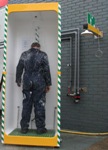
By
It is safe to assume that we never know enough, or at least don't know all that we need to know. Recent changes to hexavalent chromium and beryllium protection requirements should teach us this lesson.

By Drew D. Troyer
Preventing slip, trip, and fall accidents is a risk management proposition.
By Louise Bernstein
Before rolling out any management system, communicate your plans with all stakeholders, detailing the benefits and how it will affect their work tasks.

By Peggy Kroesch, Jim Katz
Inarguably, form must follow function. That doesn't mean, however, that form has to trail by a large distance.

By Tony Locker
The design of a safe electrical work environment starts with an arc flash assessment.
By Amanda White
It's go time! The 2014 health insurance exchange deadline is officially looming for all states.
By Henry Wright, Michelle Barker
Do they work, or do they just discourage employees from reporting injuries?
By Steven J. Luzik, Richard W. Prugh
Considerable testing of chemicals that are handled in the workplace may be required. This could include flash point, reactivity, or corrosivity.

By Richard E. Allred, Janet Dickinson
When the contaminant is a burn-inducing chemical, some argue the drenching time should be extended to a minimum of 20 and even 30 minutes of tepid water.
By Robert Pater
Remember that everyone everywhere longs for something. Desire is the most elemental part of each person.
By Jerry Laws
OSHA's jurisdiction in these emergencies is not crystal clear, at least not yet.
By
When excellence in safety is measured by zero failures, a self-limiting organizational viewpoint and very dangerous employee belief are created.